Carl Alberg's Complete Cruisers
By Tom Zydler
Cruising World Magazine, Volume 23, Number 10 -- October 1997, Page 117
© Copyright 1997 by Cruising World Publications, Inc. All rights reserved
Reproduced with permission.
Ann and Brian Lancaster have morphed their Alberg 35, Cross Town Traffic, into a real gem, the likes of which original builder Pearson Yachts never envisioned. They have upgraded the rigging, repowered with diesel, added a reefer/freezer and retrofitted a comfortable chart table inside. They've even designed and built a dinghy that fits on the coachroof like a comfortable old slipper without impairing the helmsman's visibility -- important in the Marshall Islands where they are right now, halfway through a carefully planned circumnavigation.
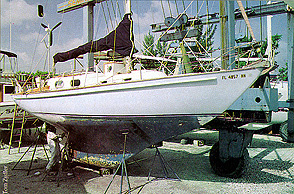 Although decidedly "thirty-something," the boats, first commissioned in 1961, continue to deliver pleasure and adventure to their owners. Chris Ogden just bought Maui, built in the last production year, 1967, and hauled her out to prepare for a cruise to the West Indies and Western Caribbean. Even on the hard, the long overhangs rise gracefully over the boxy cabin cruisers. A yard worker ground the layers of old bottom paint down to the gelcoat and revealed five small blisters -- not bad for this old lady. Inside are a grand V-berth, a cavernous chain locker, a multitude of doored storage niches and a bin for storm sails.
Although decidedly "thirty-something," the boats, first commissioned in 1961, continue to deliver pleasure and adventure to their owners. Chris Ogden just bought Maui, built in the last production year, 1967, and hauled her out to prepare for a cruise to the West Indies and Western Caribbean. Even on the hard, the long overhangs rise gracefully over the boxy cabin cruisers. A yard worker ground the layers of old bottom paint down to the gelcoat and revealed five small blisters -- not bad for this old lady. Inside are a grand V-berth, a cavernous chain locker, a multitude of doored storage niches and a bin for storm sails.
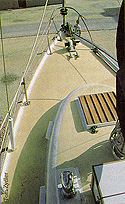 The late Carl Albert designed the 35 as a coastal cruiser. With LOA of 34'9" she has a short waterline of 24'0" and moderate beam of 9'8". Good proportions for slipping along in light air. The waterline lengthens when the hull heels, and the boat foots nicely in a breeze. Draft of 5'2" permits gunkholing in the Bahamas. Displacement of 13,000 pounds, heavy by today's standards, provides good motion at sea and the ability to carry a modern cruiser's payload.
The late Carl Albert designed the 35 as a coastal cruiser. With LOA of 34'9" she has a short waterline of 24'0" and moderate beam of 9'8". Good proportions for slipping along in light air. The waterline lengthens when the hull heels, and the boat foots nicely in a breeze. Draft of 5'2" permits gunkholing in the Bahamas. Displacement of 13,000 pounds, heavy by today's standards, provides good motion at sea and the ability to carry a modern cruiser's payload.
Added to the aesthetics, many boat buyers like the price on either side of $30,000, depending on year and condition. Fixer-uppers can be found for as little as $10,000. A 35 in top condition offers a solidly constructed hull (more than one inch thick below the waterline) capable of taking a grounding without worry for the encapsulated lead ballast of 5,300 pounds. So configured, of course, there are no keel bolts to corrode.
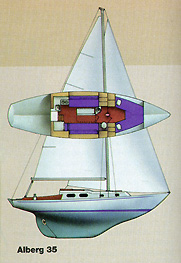 A family will enjoy the boat with her numerous bunks in the two cabin versions. In the dinette layout the cabin table drops to make a wide bunk. The whole starboard side holds a three-burner oven/stove, an icebox and food lockers. The version with the settees has a galley by the companionway. Both interiors have quarter berths. [NOTE: The settee layout does not have a quarter berth. See layout diagram. -- T. Alley] Several removable panels open for total access to the engine, and floorboards lift to reveal two monel water tanks (60 gallons) and a fuel tank (30 gallons). A deep bilge prevents any water from sloshing into lockers. With an enclosed toilet compartment with a shower sump and large hanging lockers, the boat offers comfortable seagoing quarters.
A family will enjoy the boat with her numerous bunks in the two cabin versions. In the dinette layout the cabin table drops to make a wide bunk. The whole starboard side holds a three-burner oven/stove, an icebox and food lockers. The version with the settees has a galley by the companionway. Both interiors have quarter berths. [NOTE: The settee layout does not have a quarter berth. See layout diagram. -- T. Alley] Several removable panels open for total access to the engine, and floorboards lift to reveal two monel water tanks (60 gallons) and a fuel tank (30 gallons). A deep bilge prevents any water from sloshing into lockers. With an enclosed toilet compartment with a shower sump and large hanging lockers, the boat offers comfortable seagoing quarters.
Drawbacks? Older boats will need hose and electrical wire replacement. The bulkhead under the deck-stepped mast needs beefing up as does the bottom edge of this structural piece. For offshore work I would replace the pretty but weak bronze window frames with bolted ports, or install storm window covers. The balsa-cored deck calls for a surveyor's mallet to locate any delaminations that can be labor intensive to repair. Inside, Pearson Yachts finished the bulkheads with wood-grained formica. Repainting the bulkheads with light solid colors, after first heavily sanding the surface, helps. Add varnish on the standard teak trim and the cabin will look elegant.
Carl Alberg never meant the Alberg 35 for extensive ocean cruising. For this he drew a 37-foot yawl. It compares to the 35 as does a thoroughbred to a Shetland pony, both from a good stable. The Alberg 37 raced under the CCA rule and the design has long overhangs and a short full keel ending with a raked rudder to reduce the wetted area. Showing the typical Alberg moderation of basic ratios, a slim, slippery hull only 5'6" deep with beam of 10'2" and 26'6" of LWL is powered by 646 square feet of sail (in the available sloop version). The single-spreader mainmast goes right through the coachroof to rest on a well engineered mast step -- perfect for offshore work. Apart from adding 40 square feet of sail, the mizzen can serve as a riding sail at anchor, carry a mizzen staysail or provide the option of a balanced jib-and-jigger sail plan should the fully reefed main be too big for wild conditions.
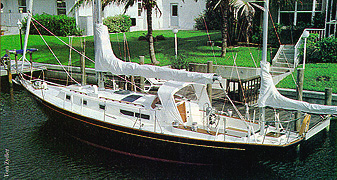 At 37'2" LOA and a displacement of 16,800 pounds, the Alberg 37 has the feel of an oceangoing yacht with wide side decks leading to the bow. Below, you get the impression of a larger boat due to ambient light and breeze from several ports and two overhead hatches. Teak bulkheads match the teak-and-holly sole with lifting floorboards for access to the tanks (60 gallons of water and 35 of fuel). The deep bilge has the volume for additional tankage, an important feature in these days of mandatory holding tanks. Apart from a large V-berth, the main cabin has two pull-out settes plus a pilot berth. Shelves for electronics bank the chart table, where a cushioned seat folds cleverly to extend a quarter berth.
At 37'2" LOA and a displacement of 16,800 pounds, the Alberg 37 has the feel of an oceangoing yacht with wide side decks leading to the bow. Below, you get the impression of a larger boat due to ambient light and breeze from several ports and two overhead hatches. Teak bulkheads match the teak-and-holly sole with lifting floorboards for access to the tanks (60 gallons of water and 35 of fuel). The deep bilge has the volume for additional tankage, an important feature in these days of mandatory holding tanks. Apart from a large V-berth, the main cabin has two pull-out settes plus a pilot berth. Shelves for electronics bank the chart table, where a cushioned seat folds cleverly to extend a quarter berth.
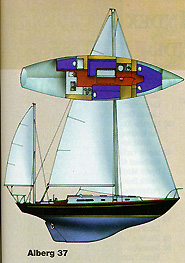 The Whitby Boat Works in Canada built Alberg 37s, sloops and yawls, in Mark I and Mark II versions between 1967 and 1988, a testimony to the longevity of a classic design. According to all reports, the builders produced a strong hull. A 1977 hull, Good News, ended up on a Block Island, Rhode Island, beach in 1991's Hurricane Bob and suffered only scratches. Since then, her second owner David Huck has cruised in her as far as Cuba and the southern Bahamas and praises her seakindly performance in sloppy Gulf Stream seas.
The Whitby Boat Works in Canada built Alberg 37s, sloops and yawls, in Mark I and Mark II versions between 1967 and 1988, a testimony to the longevity of a classic design. According to all reports, the builders produced a strong hull. A 1977 hull, Good News, ended up on a Block Island, Rhode Island, beach in 1991's Hurricane Bob and suffered only scratches. Since then, her second owner David Huck has cruised in her as far as Cuba and the southern Bahamas and praises her seakindly performance in sloppy Gulf Stream seas.
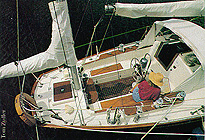 Potential buyers of the 37 should expect to pay between $35,000 and $60,000. They should employ a surveyor to examine the balsa core deck and bulheads, some of which have been known to separate from the hull. The Mark II has less wood in the construction, employing instead a molded floor support, molded overhead liner and a fiberglass toerail.
Potential buyers of the 37 should expect to pay between $35,000 and $60,000. They should employ a surveyor to examine the balsa core deck and bulheads, some of which have been known to separate from the hull. The Mark II has less wood in the construction, employing instead a molded floor support, molded overhead liner and a fiberglass toerail.
Alberg 35
|
Alberg 37
|


